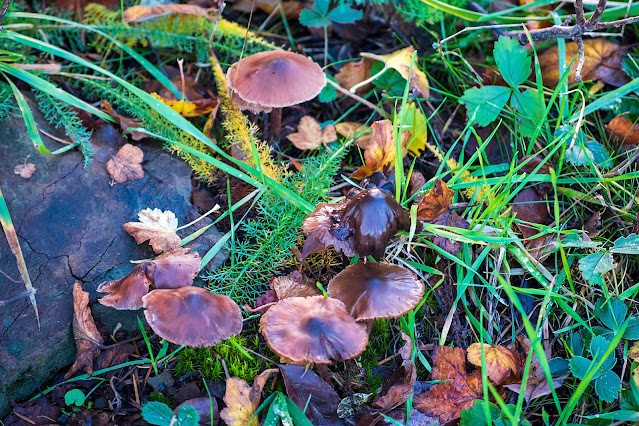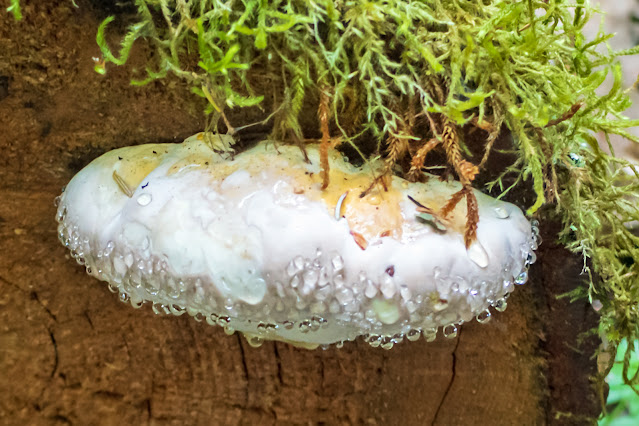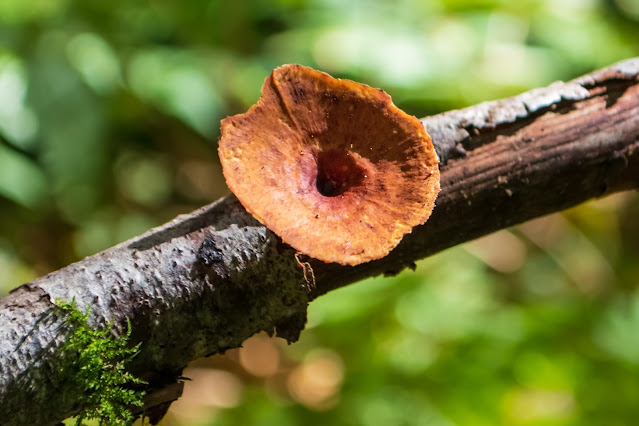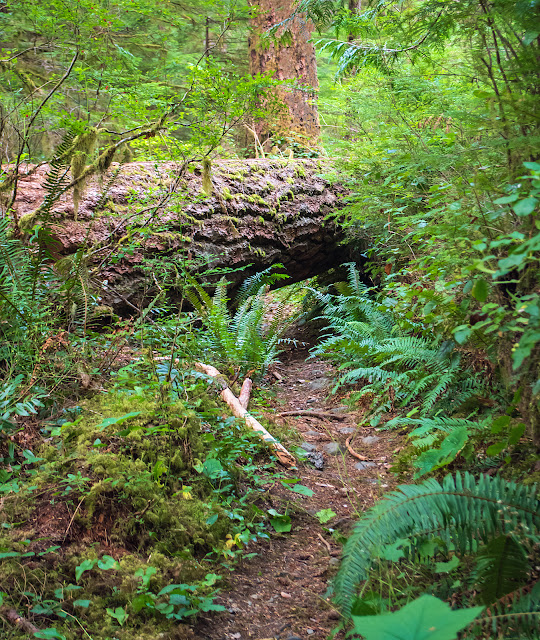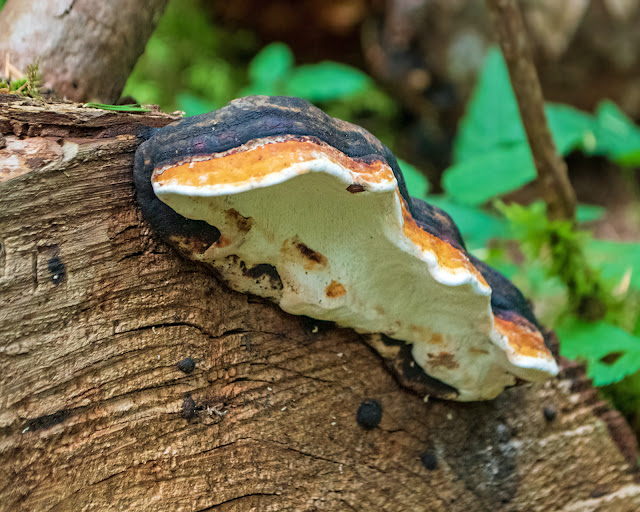I'm not very good at identifying mushrooms. I do try, but with only occasional success.
It's not that I'm new to this; I've been looking at mushrooms for decades. In the 1980s I was harvesting mushrooms for the table: pine mushrooms (Matsutake), which we sold, and ate the ones that got broken on the way down the mountainside; puffballs fried in butter, boletes (good in beefy stews if you can find ones not full of worms), shaggy manes (Coprinus comatus). I tried a local Russula; rubbery and tasteless, like chewing erasers in school. Or I can go back and back; Mom was a fan of Euell Gibbons, the wild-food enthusiast; puffballs were a favourite treat.
And some mushrooms are either so easily identified or so common in my neck of the woods, that I don't have to think twice. Red-belted polypores, the Rusty-gilled polypore, Turkey-tails, and the poisonous clan of the Amanitas. The Artist's Conk: when I was a child, many homes displayed one of these, with a scene painted on the underside. I have one that Laurie climbed a tree on Simon Fraser mountain to pick for me. I haven't painted it. Yet. There's the Cat's-tongue mushroom (aka Toothed Jelly Fungus: I love all these names!) and the tiny Birds' Nests, and the look-alike Witches' Butter and Orange Jelly. And the miniature Douglas-fir Collybia, which grows mostly from between the scales on Douglas-fir cones. And, I think, my favourite; the Lichen Agaric, both a mushroom and a lichen, looking like a delicate parasol.
But others? I look at them, take their photos, pay attention to their surroundings, and then pore through the guide books and websites, ending up saying, "Not this one. Nor this. Probably not that, either. Maybe, maybe ..."
But I find them all beautiful. And fascinating. So I keep trying.
I don't harvest them any more; our ecosystem is so fragile these days, what with the constant encroachment of human "civilization" and the changing climate, I leave them be, try not to damage them in any way.
On a friend's lawns a few blocks away, mushrooms sprout everywhere this time of year. Sometimes we find them entire and unblemished. But something, something, maybe a local bear, knocks many of them over, leaving shreds scattered about. A good opportunity to look at undersides and touch-test them, guilt-free.
 |
| White, straight, gills. And a smaller mushroom with gills visible through the traslucent cap. |
Questions I ask when I get the chance to examine a mushroom from beneath:
Does it have gills? Or pores?
Are the gills crowded or loose? Do they go from the stem to the rim without a break?
Do they end at the stem or continue down it? Are they attached or separate from the stem?
 |
| Two pieces, as found. The cap is slightly moist, not quite sticky, not slimy. |
Here, I get a look at the construction of the stalk. It is not hollow, but has a smoother inner section. I had read that the Russulas' stalks break cleanly, like chalk. I snapped this one. I'm not quite sure; the outer skin peels; the inner section snaps. I think it's probably a Russula.
 |
| Base of the stalk. |
Is the stalk straight? Does it have a ring around the base, or under the cap? Is it smooth? Is the base enlarged?
A few steps away, I found this mushroom:
 |
| Not gills, but pores. |
On our common shelf mushrooms, polypores, the pores are pinpricks or smaller. Boletes, or at least all the boletes I have looked at, have slightly larger pores. This one has large, wide-open pores.
 |
| Another piece, of a similar mushsroom. |
This was all I found of this particular mushroom. It was that red colour, as shown. Probably the same species as the one above, just older.
And these were smaller, and intact.
 |
| Tan gilled mushroom. With fingertip for size. |
Here the gills have long blades, stalk to rim, and other half blades, between them, along the rim.
 |
| A small group. Notice how the gills are separate from the top of the stalk. |
And, as usual, I can't identify the species of these mushrooms. It doesn't matter, really. I'm not going to try to eat them. Leave that to the bears. And the slugs.
~~~~~~~~~~~~~~~
No tengo mucho éxito al tratar de identificar los hongos. Hago el intento, pero solamente de vez en cuando puedo nombrar alguno.
No es que me falte experiencia; he estado cosechando hongos desde hace décadas. Alrededor del año 1980 recogía hongos para la mesa: el hongo pino (
Matsutake), los cuales vendíamos, y comíamos los que se rompían al bajarlos del cerro donde crecían; hongos polvera, fritos en mantequilla; los
Boletus sp. (sabrosos en un guisado de carne de res, si se pueden encontrar algunos sin gusanos); hongo tinto (
Coprinus comatus). Probé un
Russula; sin sabor y con la textura de una goma como las que usas para borrar errores en la escuela. O puedo ir más atrás; mi mamá era aficionada del escritor
Euell Gibbons, que escribía sobre los alimentos silvestres; nos preparaba antojitos de hongos polvera.
Y hay hongos que se pueden identificar muy facilmente, o que son tan comunes en la isla que no tengo ni que pensarlo; ya sé que son. El conk de cinturón rojo,
Fomitopsis pinicola, el políporo de laminillas rojizos,
Gloeophyllum saepiarium, los llamados Cola de Pavo, y el clan de los
Amanita sp. tan tóxicos. El Conk del Artista; cuando era niña, en muchas casas veía estos, pintados con escenas típicas. Tengo uno que me bajó Laurie de un árbol en el cerro Simon Fraser; todavía no lo he pintado. Y hay el hongo Lengua de Gato (también llamado hongo de dientes gelatinosos: ¡me gustan estos nombres!) y los Nidos de Pájaro, tan pequeños, y los casi idénticos Mantequilla de Brujas y la Jalea Anaranjada. Y el honguito Collybia de Abeto de Douglas, que crece de entre las escamas en los conos que producen los abetos de Douglas. Y tal vez mi favorito, el
Lichenomphalia umbellifera, tanto un líquen como un hongo, y que parece una sombrilla miniatura.
¿Pero los otros? Los miro, les saco unas fotos, me fijo en su ambiente, y luego busco en mis libros guía y en sitios web, y termino por decir — No es este. Ni este. Ni tampoco ese, creo. Puede ser ... tal vez...
Pero todos los encuentro hermosos. Y fascinantes.
Ya no cosecho hongos. Nuestro ecosistema estos dias es tan frágil, tan amenazado por nuestras construcciones, y por el cambio del clima; dejo todo en paz, tratando de no hacer daño.
En el césped de una amiga, los hongos aparecen por dondequiera en esta temporada del año. A veces los encontramos enteros, sin manchas. Pero algo, algún animal, tal vez un oso que anda por el rumbo tumba muchos, dejando pedacitos regados. Es una buena oportunidad para mirarlos con más detalle, sin culpa.
Fotos:
- Carne blanca, con laminillas derechitas. También hay un honguito donde se ven las laminillas atravez del sombrero. Las preguntas que me hago cuando puedo examinar las laminillas: ¿Son laminillas, o poros? ¿Las laminillas; están apretadas o separadas? ¿Van desde el tallo hasta el borde del sombrero o no? ¿Terminan al llegar al tallo, o siguen bajando una pequeña distancia? ¿Están fijas o separadas del tallo?
- Dos pedazos, como los encontré. La superficie del sombrero es un poco húmeda, apenas pegajosa, pero no resbalosa. El tallo, cortado, no tiene hueco en el centro. Había leido que el tallo de las especies de Russula se rompen de golpe, como por ejemplo se rompe una ramita bien seca. Rompí este. No estoy segura, pero parece ser Russula; la carne se rompió limpiamente; solo la corteza se separó en tiras.
- Base del tallo. ¿El tallo, es derecho? ¿Tiene la base hinchada? ¿Tiene un anillo alrededor de la base, o debajo del sombrero?
- A una poca distancia, encontré este hongo tumbado. No tiene laminillas, sino poros. Los políporos locales tienen poros tan pequeños como el punto de un alfiler. Los boletus, por lo menos los que he examinado también tienen poros; los que he visto antes son, a lo más, como la cabeza de esos alfileres. Este hongo tiene poros grandes, bien abiertos.
- Otro pedazo, probablemente de la misma especie. Estaba de este color rojo intenso; tal vez sea más viejo.
- Honguitos tirados, estos con laminillas de dos tamaños; unas que van desde el tallo hasta el borde del sombrero, otras que se apegan nada más al borde.
- Un grupo. Se ven como las laminillas están separadas del tallo.
Y como es costumbre, no puedo identificar estos hongos con confianza. No importa, en verdad; no pienso comerlos. Eso lo puedo dejar a los osos. Y las babosas.


